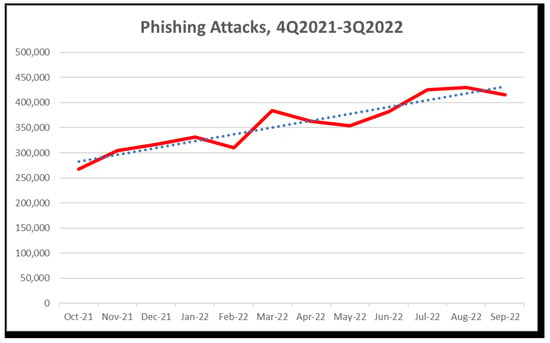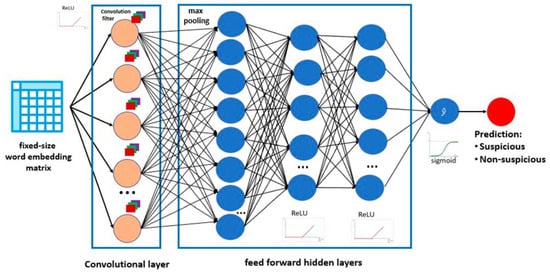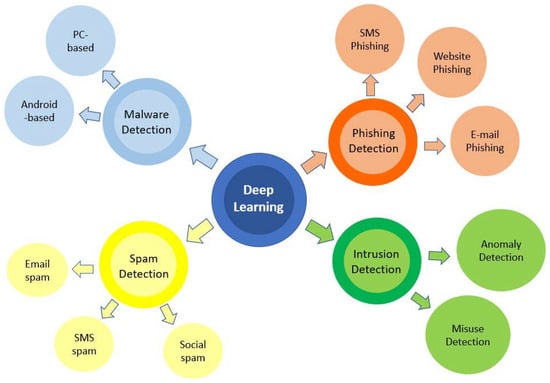You're using an outdated browser. Please upgrade to a modern browser for the best experience.
Please note this is a comparison between Version 1 by Samer Atawneh and Version 2 by Camila Xu.
Email phishing is a widespread cyber threat that can result in the theft of sensitive information and financial loss. It uses malicious emails to trick recipients into providing sensitive information or transferring money, often by disguising themselves as legitimate organizations or individuals. As technology advances and attackers become more sophisticated, the problem of email phishing becomes increasingly challenging to detect and prevent.
- email phishing
- convolutional neural networks (CNNs)
- long short-term memory (LSTM)
- recurrent neural networks (RNNs)
- bidirectional encoder representations from transformers (BERT)
1. Introduction
The increasing acceptance and adoption of IT has led to increased web-based activities provided via cyberspace [1]. According to Adewole et al. (2019) [2], these activities span from essential services such as education and financial transactions to basic activities such as e-health apps and social media. According to research, activities such as social media, online gaming services, and financial transactions are considered top web-based activities with vast popularity and enormous userbases [3]. Many users of these web-based solutions indicate the acceptance of IT in recent times. The objective is to make the web-based solutions that are used daily more available and accessible. However, because there are no universal security controls in cyberspace, the open availability and accessibility of these web-based solutions open the door to cyberattacks [4].
Phishing is a crime affecting everyone, including organizations and governments worldwide. Email phishing is a typical cyberattack that can have serious consequences, including financial loss, identity theft, and damage to an organization’s reputation. The number of people victimized by phishing scams has grown exponentially over the past decade, with millions of victims each month. This growth presents an increasingly difficult challenge for organizations to protect themselves from this growing threat. Nowadays, email phishing has become increasingly challenging to detect and prevent. Phishers constantly evolve their methods to evade detection by security solutions and law enforcement agencies. Organizations must be able to detect and prevent these attacks at scale if they wish to avoid falling victim to this threat. Vrbančič et al. (2018) [5] define the phishing attack as pervasive fraud that occurs when a fake website imitates a real one in order to acquire data from unsuspecting users. A duplicate website that resembles a legitimate website is created for phishing, making it difficult for users to detect [6]. Nowadays, phishing is a widely known subject, and the impact of successful phishing attacks has become disastrous [4]. Phishing attacks have put legitimate web resource owners and internet users at risk [5]. Even with powerful antivirus software, the recent rise in phishing attacks has led to a lack of trust in legitimate users, making them feel less safe.
According to a report released by the Anti-Phishing Working Group (APWG) in 2022, there were 1,097,811 phishing assaults in Q2 2022. There was a total of 1,270,883 phishing assaults recorded by APWG in quarter three of 2022 (Figure 1), making it the worst quarter for phishing ever recorded by the organization. In early 2020, APWG saw between 68,000 and 94,000 phishing assaults per month; by the end of 2022, that figure had tripled [7].

Figure 1. Phishing attacks from October 2021 to September 2022 [7] (red line depicts the actual number of attacks, blue dashed line depicts the approximate increase).
Deep learning is a machine learning type that involves using artificial neural networks (ANNs) to analyze and classify data. A neural network can process and learn from large amounts of data, making it practical for text and image classification [8].
2. Background
Deep learning algorithms can learn from data by adjusting the weights and biases of the artificial neurons in the network, allowing them to adapt and improve their performance over time (Figure 2). This makes deep learning particularly useful for tasks with a large amount of data available, as algorithms can learn from these data to make more accurate predictions or classifications [8].
Cybersecurity is one of the most important and complex fields in the 21st century. Cybersecurity includes many sub-fields, such as network security, data security, application security, etc. In this field, many new techniques are coming up daily for detecting and overcoming cyber threats. Learning about these techniques is not enough because it only helps one understand the terminology or find vulnerabilities but will not help one perform actions against cyber threats. To perform actions against cyber threats, one must learn how to develop cognitive skills [10].
While one can protect their organization in many ways, one of the best ways is to use artificial intelligence (AI) in cybersecurity (Figure 3). Artificial intelligence can quickly analyze vast amounts of data and accurately identify threats without human interaction. Machine learning, deep learning, or any other form of AI can be extremely effective for this task because it processes large amounts of data in an unsupervised manner using a previously trained model simultaneously and in a fast way [11].
Deep learning has shown great potential for use in cybersecurity, particularly in intrusion detection, malware classification, and phishing detection. One example of using deep learning in cybersecurity is intrusion detection, where algorithms can be trained to recognize patterns and anomalies in network traffic that may indicate a potential security threat [12]. Deep learning has also been used for malware classification, where algorithms are trained to identify malicious software based on features such as file structure and behavior. In phishing detection, deep learning algorithms have been used to classify emails as either legitimate or fraudulent based on features such as subject line and content [13]. Overall, deep learning in cybersecurity can significantly improve the effectiveness of security measures by allowing algorithms to learn and adapt to new threats in real time.
3. The Latest Techniques for Detecting and Protecting against Various Email Phishing Attacks
This section will discuss the latest techniques for detecting and protecting against various email phishing attacks, including machine learning, deep learning, and hybrid models. This section will also cover different deep learning models that are commonly used in email phishing detection, such as CNNs, RNNs, LSTM networks, and BERT.
3.1. Machine Learning Approaches
The authors of [6] proposed a phishing detection model that utilizes multiple machine learning algorithms to enhance the overall performance and robustness of the model. The system extracts a set of features from the website, including URL and HTML content, and then these features are used to train the models. The experiment was conducted on a dataset of phishing and legitimate websites, and it was found that the system achieved high accuracy in detecting phishing websites, with the best results using random forest and support vector machine methods. However, the approach is not generalized to a new unseen dataset and is limited to phishing website detection.
In their paper, Valecha et al. (2021) [14] proposed a method for detecting phishing emails using persuasion cues. The research specifically focuses on gain and loss persuasion cues. It creates three machine learning models using these cues: one with relevant gain persuasion cues, one with relevant loss persuasion cues, and one with a combination of gain and loss persuasion cues. The models were then compared to a baseline model that does not account for the persuasion cues. The results indicated that the models with relevant persuasion cues outperformed the baseline model by around 5–20% in terms of F-score, showing that including persuasion cues in anti-phishing methods can effectively detect and block phishing emails.
3.2. Deep Learning Approaches
In their paper, the authors of [15] developed a spam filter that combined an integrated distribution-based balancing approach with an N-gram tf-idf feature selection and a deep multilayer perceptron neural network with rectified linear units. This filter accurately detected spam emails in the Enron and SpamAssassin benchmark datasets, even when many different features and additional layers were present. The authors found that accuracy decreased as the number of features decreased, but the ANN and decision trees still performed well with minimal datasets. They also noted that shallow neural networks are unsuitable for high-dimensional datasets and are computationally expensive, so they incorporated N-gram tf-idf feature selection in their approach. Overall, the proposed filter effectively detected spam emails through the integrated distribution-based balancing approach [15].
In their work, the authors of [16] presented a phishing email detection model called THEMIS that utilized an improved recurrent convolutional neural network (RCNN) model with multilevel vectors and attention mechanisms. This model could simultaneously model email headers, words, email body, and characters, allowing it to identify phishing emails effectively. To evaluate the effectiveness of their model, the authors used an unbalanced dataset from the First Security and Privacy Analytics Anti-Phishing Shared Task (IWSPA-AP 2018). The evaluation of THEMIS resulted in a high accuracy of 99.848% and a low false-positive rate of 0.043%, demonstrating the model’s effectiveness in detecting phishing emails using natural language processing. Overall, Fang et al. (2019) [16] presented a promising phishing email detection model that could be used to improve the security of email systems.
Alhogail and Alsabih (2021) [17] proposed a phishing email detection model that utilized deep learning and natural language processing on the email body to extract features and improve phishing detection. The model was based on a convolutional network (GCN) and was developed as a supervised learning model. The model was trained and tested on a publicly available fraud dataset, including phishing and legitimate emails. The dataset was balanced and suitable for use in supervised learning algorithms. The experimental results showed that the proposed model attained a 98% accuracy rate and a false-positive rate of 0.015%, demonstrating the model’s effectiveness in detecting phishing emails. Overall, the study by Ref. [17] highlighted the potential of using machine learning and natural language processing techniques to improve the security of email systems by detecting phishing emails. In their work, Yao et al. (2019) [18] explored using graph convolutional networks (GCN) for text classification. The authors proposed a GCN-based model for text classification and evaluated its performance on several benchmark datasets. The results showed that the proposed model achieved competitive performance compared to other state-of-the-art models and demonstrated the potential of using GCN for text classification tasks. Overall, the authors of [18] presented a promising approach for text classification using GCN and highlighted the potential of this technique in various natural language processing tasks.
The authors of [19] conducted a study on deep learning techniques for detecting spam emails in English-language text emails. The authors proposed a model that utilized deep learning to classify spam emails based on features extracted from the text of the emails. The model was developed as a supervised learning model and was trained and tested on a dataset of spam and non-spam emails. The results of the study showed that the proposed model was able to achieve high accuracy in detecting spam emails. The authors also discussed the potential applications and future directions for using deep learning techniques in spam email detection. Overall, Ref. [19] highlighted the potential of using deep learning to improve the security of email systems by detecting spam emails.
In their work, Singh et al. (2020) [20] conducted a study on using deep learning techniques for detecting phishing attacks from URLs. The authors proposed a model that utilized deep learning to classify URLs as either phishing or non-phishing based on features extracted from the URL. The system can achieve an accuracy of 98.00%, outperforming a previous model that achieved 97.98% accuracy. One of the system’s benefits is that it does not require manual feature engineering, as CNNs can extract relevant features directly from the URLs. This is a significant advantage over previous approaches, which can be time-consuming and labor-intensive. Overall, the system represents a promising solution for detecting and preventing phishing attacks.
Saha et al. (2020) [21] proposed a framework for detecting phishing web pages using deep learning techniques. They used a multilayer perceptron, or feed-forward neural network, to analyze a dataset of 10,000 web pages collected from Kaggle. The dataset includes ten attributes, such as the URL, the website’s age, and the presence of certain words or symbols. The authors preprocessed the data by converting categorical attributes to numerical values and splitting the dataset into training and test sets. They then trained the multilayer perceptron on the training data and evaluated its performance on the test data. The model achieved 95% accuracy on the training data and 93% on the test data. The authors concluded that deep learning approaches can effectively detect phishing attacks and suggested that further research may be beneficial. They also noted that their framework could be improved by incorporating additional features or using more advanced deep learning techniques.
By analyzing the content of email messages, McGinley and Monroy (2021) [22] validated the effectiveness of CNN models in identifying phishing emails, achieving an accuracy rate of 98%. The proposed model takes an embedding of text in the body of an email as input and outputs a probability that indicates the possibility that the email is malicious. Fetooh et al. (2021) [23] proposed a real-time attack detection model for wireless networks that analyzes several static and dynamic parameters while conduct a frame-type analysis in order to detect various wireless attacks. The evaluation revealed that the model’s average accuracy was 94.40%.
Gogoi and Ahmed (2022) [24] proposed a deep learning model that employs the BERT and DistilBERT pre-trained transformer models to detect phishing. The proposed detection model successfully addressed the difficulties in phishing detection, such as how conventional feature extraction approaches are ineffective in identifying phishing emails, achieving an accuracy rate of 99%. Doshi et al. (2023) [25] proposed a deep learning detection model to classify phishing and spam emails by incorporating email body and content features. The proposed model effectively addresses the problem of data imbalance in spam classification and email phishing with accurate classification. The model relies on a dual-layer architecture with a learned or pre-trained model in each layer that categorizes data instances into the appropriate classes. The proposed model employed ANN, RNN, and CNN models. The achieved accuracy rate was 99.51%.
Benavides-Astudillo et al. (2023) [26] recently proposed a phishing attack detection model that employs deep learning and natural language processing to identify phishing attacks on web pages. The detection system was created using the Phishload dataset. To extract features, the text content of the web pages is analyzed. After training the model, the obtained validation accuracy was 98%. In their work, Aldakheel et al. (2023) [27] presented a detection model for identifying phishing websites, where a CNN was utilized to separate legitimate websites from phishing websites effectively. The effectiveness of the proposed detection model was evaluated using the PhishTank dataset, a popular dataset for identifying phishing websites based just on URL features. The achieved accuracy rate was 98.77%.
3.3. Hybrid Approaches
In their paper, He et al. (2022) [28] proposed a double-layer detection framework based on deep learning technology for detecting social engineering attacks, which uses phishing emails as the medium and targets specific groups of people. The first layer of the system uses machine learning algorithms, specifically the long short-term memory (LSTM) and the extreme gradient boosting tree (XGBoost), to detect phishing emails. In contrast, the second layer uses a bidirectional LSTM and attention mechanism to detect insider threats. The framework also includes a social engineering attack and defense simulation platform. The system does not require manual feature extraction and can accurately identify phishing emails and insider threats. The experimental results showed that the proposed framework effectively detected phishing attacks and insider threats faced by enterprise systems and can be used in real-world situations. Bagui et al. (2019) [29] developed a novel model that applies machine learning, deep semantic analysis, and deep learning techniques to classify emails as phishing or non-phishing. They used one-hot encoding with and without word phrasing for deep semantic analysis. They compared the results of several machine learning classifiers, such as SVM, decision tree, and naive bayes, and deep learning classifiers like LSTM, CNN, and word embedding. The authors used deep learning techniques to analyze the text of emails and extract inherent characteristics for phishing detection. Overall, the authors aimed to improve the accuracy of detecting phishing emails by applying deep learning and semantic analysis techniques to classify emails.


